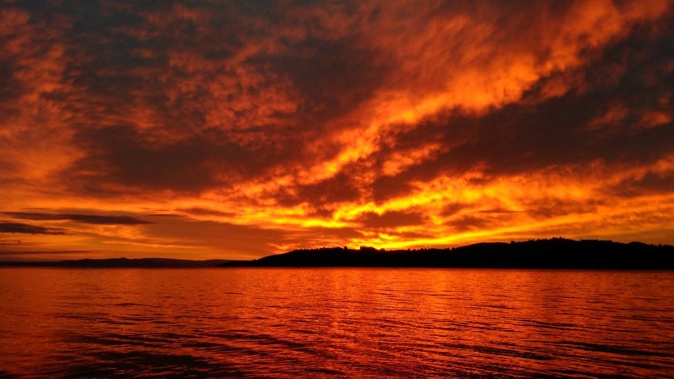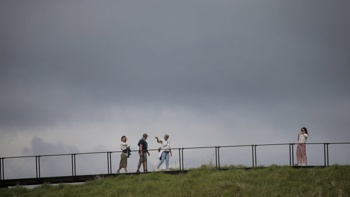
New Zealand’s best-known super-volcano is on the verge of moving into one of its longest periods of unrest in modern times, with one expert giving “50-50″ odds over Taupō's episode rumbling on.
The enormous hidden caldera’s eight-month bout, which initially prompted officials to raise its alert level for the first time ever, comes as some of the world’s top volcanologists descend on Rotorua for the country’s biggest conference in three years.
Scientists suspect Taupō latest activity is a result of magma moving around within it and jostling for space, possibly because of new magma coming up from below.
They’ve now observed more than 1650 related quakes – including a 5.7 event on November 30 that triggered a small tsunami in Lake Taupō and generated hundreds of aftershocks.
It’s since also been shown to have caused around 180mm of ground movement at Horomatangi, where researchers recently pinpointed a 250 cubic km magma chamber.
“We’re still seeing what we call post-seismic deformation, or the elastic rebound left by the 5.7 earthquake, at Horomatangi, although the rest of the stations are pretty much running at noise level,” GNS Science volcanologist Brad Scott said.
“We think we’ve had just enough time now to see that no significant trends are developing.”
What happened next at Taupō wasn’t exactly clear – but if the episode carried on into 2023, it’d prove among the lengthiest ever observed there.
“Of the larger periods of unrest that we know about in the last 150 years, the average duration is about eight months – which is about where we are now,” Scott said.
“At the moment, the probabilities are 50-50 of it decreasing or becoming a longer-than-normal period of unrest.”
Nonetheless, the chances of the episode turning into something much more significant were small, and of 17 such periods over 150 years, none ended with a big event.
“There’s nothing screaming out to say this is escalating and it’s going to get worse ... there’s nothing pointing toward eruption.”
Taupō - regarded as the world’s most frequently active super-volcano system - was indeed capable of generating them.
Its 300,000-year eruptive history notably included the gigantic Oruanui eruption around 25,400 years ago, in which more than 1100 cubic kilometres of pumice and ash was spewed into the planet’s atmosphere.
Since then, there have been about 28 smaller ones we know of: the most recent being the Hatepe eruption 1800 years ago, which was still big enough to obliterate the surrounding landscape.
Yet the odds of any big blow in the near future remained tiny.
One 2020 modelling study put the annual probability of eruption at any size at a very low chance of one in 800 – or at between 0.5 and 1.3 per cent - within the next 500 years.
Scott said this unrest period rather stood out over the fact GeoNet had been able to capture, in unprecedented detail, occurrences like November’s quake and the tsunami it created.
“We’ve been able to collect a phenomenal amount of data from that, just by having GPS, lake-levelling and earthquake datasets in place,” he said.
“We’re also going to learn a lot about tsunamis in large lakes. We’ve always known that caldera lakes can be a source of local-source tsunami, but this is the first time we’ve captured one.
/cloudfront-ap-southeast-2.images.arcpublishing.com/nzme/LN5L3HNKRNCU7AQRAA5NPN2TDY.jpg)
Source / GNS Science
“But in terms of the stronger episodes we know about, it hasn’t quite got up there yet; in earlier ones in the 1920s and 1960s, numbers of earthquakes were being felt per day, whereas with this one we’ve had them being felt each, or just every other week.”
Scott said it’d been positive to see GeoNet’s raising Taupō's alert level hadn’t prompted panic – something which reflected public engagement done through programmes like the $8.2m MBIE-funded ECLIPSE project.
New insights into our resident super-volcanoes gained through that effort – which has brought together experts from Victoria, GNS Science and Massey University – are being shared at this week’s IAVCEI Scientific Assembly, drawing more than 900 scientists from 41 countries.
Many presentations in the five-day conference are focusing on caldera systems like Taupō and nearby Okataina Volcanic Centre, which last burst to life with the 1886 Mt Tarawera event that destroyed the famous Pink and White Terraces.
“One of the biggest questions we have for calderas are how these systems go from being passive to angry,” Scott said.
“It can take decades or longer for calderas to accumulate a few cubic kilometres of molten material, but what triggers it? When does it go from being a passive body of plastic rock to something more excited?”
The public will also be invited to meet world-renowned experts at Volcano Fest, held from 10am to 4.30pm at the Rotorua Energy Events Centre on Thursday.
Take your Radio, Podcasts and Music with you









